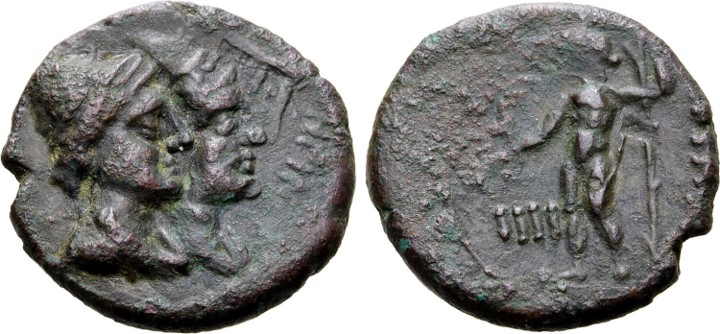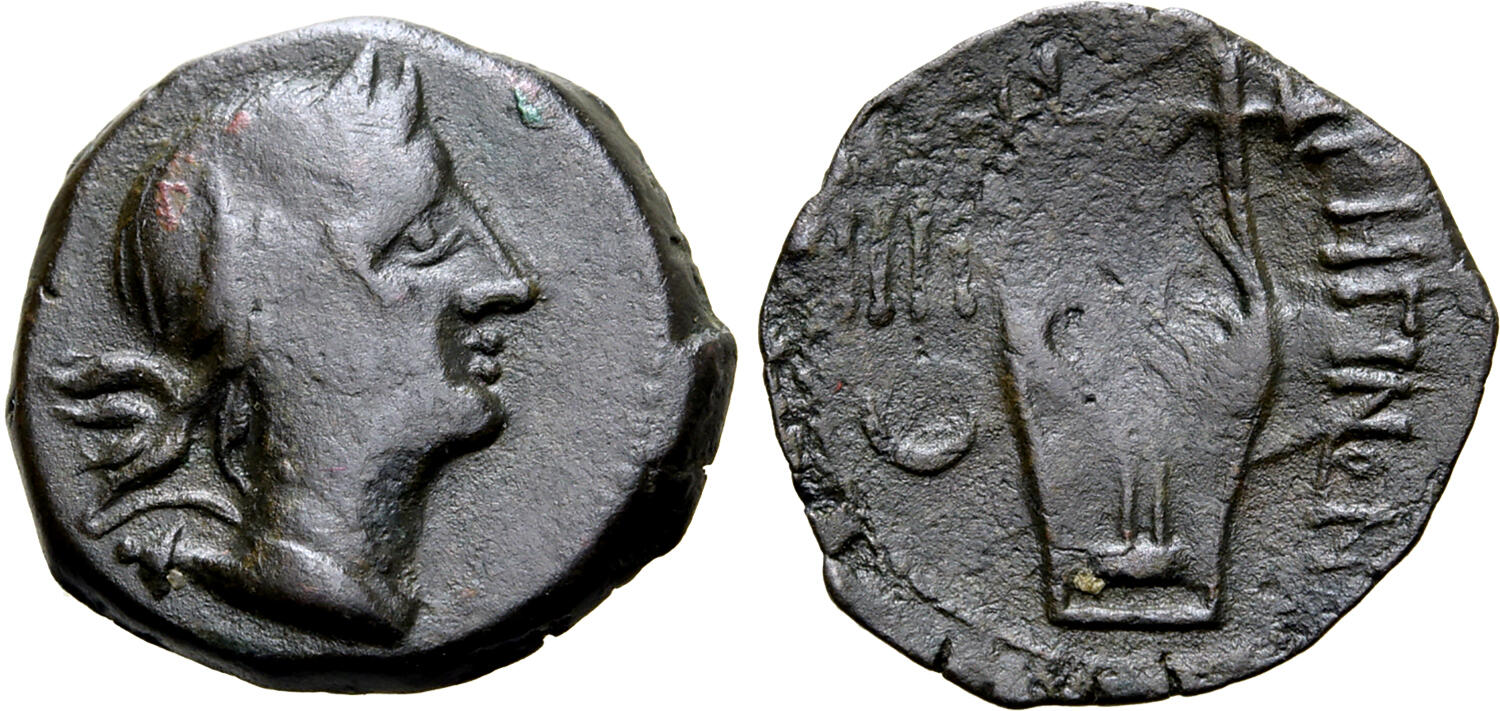210 BCE - 150 BCE | ΡΗΓΙΝΩΝ
Overstriking coin
Rhegium_Roma_Numismatics,_The_Anders_Collection_Part_II,_1_June_2023,_891.jpg
[1]
Overstruck variety
Rhegion Apollo Lyre.jpg
[2]
|
|
Sale(s)Sale(s) ᵖ:
|
Roma Numismatics, The Anders Collection Part II, 1 June 2023, 891
|
| Private collection(s)Private collection(s) ᵖ:
|
From the Anders Collection, collector's tickets included.
|
|
Description
| ObverseInscription or printing placed on the obverse.:
|
Jugate draped bust of the Dioskouroi right, wearing pilei. Border of dots.
|
ReverseInscription or printing placed on the reverse.:
|
ΡΗΓΙΝΩΝ (Greek) Asclepius facing, naked, holding scepter in left hand, a bird on right arm. In left field, IIII (value mark).
|
Mint and issuing power
| MintIdentifies the place of manufacture or issue of a numismatic object.:
|
Rhegium
|
Ancient regionAncient region.
|
Bruttium
|
Modern countryModern country: Italy
|
AuthorityIdentifies the issuing power. The authority can be "pretended" when the name or the portrait of X is on the coin but he/she was not the issuing power. It can also be "uncertain" when there is no mention of X on the coin but he/she was the issuing power according to the historical sources:
|
|
Chronology
| FromIdentifies the initial date in a range assigned in a numismatic context. 210 BCE toIdentifies the final date in a range assigned in a numismatic context.. 150 BCE
|
Hellenistic 323-30 BC  periodTime period of the numismatic object. periodTime period of the numismatic object.
|
Physical description
MetalThe physical material (usually metal) from which an object is made.: Bronze 
|
WeightWeight of the numismatic object (in grams). in grams: 3.773.77 g <br />3,770 mg <br />
|
DenominationTerm indicating the value of a numismatic object. Examples: tetradrachm, chalkous, denarius.: trias
|
AxisDescribes the directional relationship between the obverse and reverse of a numismatic object.: 1111 mm <br />1.1 cm <br />
|
| DiameterDescribes diameter of an object (in mm).: 1717 mm <br />1.7 cm <br />
|
|
References
Description
| ObverseInscription or printing placed on the obverse.:
|
Head of Artemis to right, bow and quiver over shoulder
|
ReverseInscription or printing placed on the reverse.:
|
ΡΗΓΙΝΩΝ downwards to right (Greek) Kithara, IIII (mark of value) and crescent to left
|
Mint and issuing power
| MintIdentifies the place of manufacture or issue of a numismatic object. ᵖ:
|
Rhegium
|
Ancient regionAncient region. ᵖ
|
Bruttium
|
Modern countryModern country: Italy
|
AuthorityIdentifies the authority in whose name (explicitly or implicitly) a numismatic object was issued. ᵖ:
|
|
Chronology
| FromIdentifies the initial date in a range assigned in a numismatic context. 211 BCE toIdentifies the final date in a range assigned in a numismatic context.. 200 BCE
|
periodTime period of the numismatic object.
|
Physical description
| DenominationTerm indicating the value of a numismatic object. Examples: tetradrachm, chalkous, denarius. ᵖ:
|
trias
|
|
|
References
References
- a b Troxell, Hyla A. (1975), Sylloge Nummorum Graecorum ANS 3. The Collection of the American Numismatic Society. Sicily 3 (Bruttium-Sicily I: Abacaenum-Eryx), New-York, pl. 38.
- a b Rutter N. Keith et alii (eds.) (2001), Historia Numorum Italy, London, xvi, 223 p., 43 pl.
- a b Hoover, Oliver D. (2018), The Handbook of Greek Coinage Series, Volume 1. Handbook of Coins of Italy and Magna Graecia, Sixth to First Centuries BC., Lancaster-London, 2018, lxi, 527 pages, 23 cm

